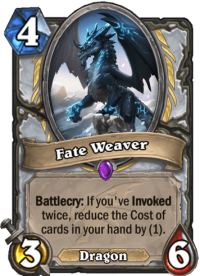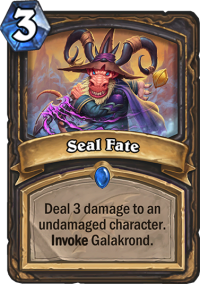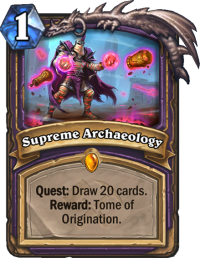The Descent of Dragons expansion introduced Galakrond Hero cards to Hearthstone in December 2019, and they have pushed through the Standard rotation mostly unscathed. Everyone can still get all five Galakrond Hero cards and two copies of the Shield of Galakrond synergy card upon opening a pack of Descent of Dragons, so they are also an attractive option for budget players.
How good are the Galakronds right now? Will they stay on the top for the entire year until they rotate out of Standard in April 2021? Is this a good thing or a bad thing? In this article, I take a look at the current state of all five Galakrond Hero cards, and what we can expect from them in the future.
Galakrond Priest

Priest is completely dominated by Galakrond, the Unspeakable. The Priest rework removed almost all burst potential from the class, so almost all Priest decks in the game are slow. There have been some attempts to build Tempo Priest decks, but they have largely failed, and every slow Priest deck in the meta is built with Galakrond as one of the key pieces because it offers you access to infinite resources. Even if you try to combo with Priest – and you can do some things with Reckless Rocketeer + Grave Rune – you have to use Galakrond in your deck to gain access to the discounts from Fate Weaver.
The question is not so much whether you include Galakrond in your Priest deck, but more of the flavor you build around your Galakrond.
The most common flavor of Galakrond Priest is packed with removal and thievery and uses its opponent’s resources against them. For example, Zanananan reached #15 Legend with this list:
There is also a faster variant that has been pioneered by NoHandsGamer. It is sometimes called Tempo Galakrond Priest or Cube Priest and it has the ability to rapidly improve its board position with Psyche Split and Grave Rune, but it has considerably fewer removal tools for a prolonged control game. So far, the faster variant shows more promise against Demon Hunter and Druid while being weaker in the other matchups, but the prevalence of those two classes on the ladder has made it an increasingly popular option. Gle’s take on this faster variant looks like this:
Priest’s Galakrond also provides budget players with access to the cheapest control deck in the game at only 2560 dust:
Ironically, the budget Priest deck is even more control-oriented than the full-cost decks because it lacks the big swing turns the expensive Legendary cards can provide.
Priest’s Galakrond is hard to ignore for any control deck: it is the ultimate control hero that can generate infinite value. Because Fate Weaver is linked to Priest’s Galakrond, and discount effects are usually immensely important for combo decks, any Priest combo decks are also naturally drawn to Galakrond. With Priest’s class identity shaping up to be a slow control class, it is hard to see how anything could displace Galakrond as a key part of all Priest decks for the next year.
Galakrond Rogue

Rogue is also totally obsessed with Galakrond, the Nightmare. For a class that used to be all about using your limited resources in the best possible way to find a lethal out before the opponent can stabilize, Rogue has undergone a major shapeshift. Aggressive Rogue decks simply cannot race Demon Hunters effectively enough, so the tempo swing from Galakrond is a mandatory tool for them all. Incidentally, Galakrond also provides Rogue with an infinite value engine in the form of endless Lackeys for slower matchups.
The only question for Rogues is which flavor of Galakrond to pursue. Vanilla? Stealth? Secret? Highlander? No matter the Rogue deck you choose, you first put in the Galakrond package and then start to wonder about the rest.
Recently, Stealth Galakrond Rogue has become the most common option, such as this Tyrano’s #10 Legend list:
For more adventurous souls, Highlander Galakrond Rogue can offer some high-variety games. Here is Jambre’s take on the archetype:
- 0Backstab1

- 0Shadowstep1

- 1Blackjack Stunner1

- 1Bloodsail Flybooter1

- 1Dragon’s Hoard1

- 1Pharaoh Cat1

- 1Praise Galakrond!1

- 1Spymistress1

- 2Ambush1

- 2Bamboozle1

- 2Dirty Tricks1

- 2Eviscerate1

- 2Shadowjeweler Hanar1

- 3EVIL Miscreant1

- 3Edwin VanCleef1

- 3Seal Fate1

- 4Vendetta1

- 6Flik Skyshiv1

- 6Heistbaron Togwaggle1

- 7Galakrond, the Nightmare1

The power of Galakrond is enough to even keep Budget Rogue decks viable, such as this list that I built:
For Rogue, the future of Galakrond is less clear. In theory, Rogue can use aggressive strategies for which Galakrond could be too slow. It simply does not have fast enough tools right now, but the next expansion could conceivably bring about the return of Aggro Rogue decks that would not include a seven-mana card like Galakrond. However, for any slower strategies – including combo strategies thanks to Umbral Skulker – Galakrond seems like a certain pick.
Galakrond Shaman
If a class has Galakrond, but no one plays the class, does that Galakrond exist?
Galakrond alone cannot carry a class, but there is no denying that Shaman’s Galakrond is also a powerful card. Shaman has experimented with various aggressive strategies without Galakrond: Totem Shaman, Evolve Shaman, and Burn Shaman, but nothing has brought the class major success in Ashes of Outland.
The most run-of-the-mill Shaman deck is still Evolve Galakrond Shaman, such as this take on the archetype by Jambre:
There have been attempts to build slower Shaman decks without Galakrond, but the ones with Galakrond have remained more successful. Nonetheless, Shaman’s Galakrond is on shakier ground than Priest’s or Rogue’s because Shaman’s Galakrond offers a far lower payoff. With suitably strong late-game cards, it could end up getting cut even from slow Shaman decks.
Galakrond Warlock

Warlock is an excellent example of how to reduce the importance of Galakrond for a class. Ashes of Outland included Kanrethad Ebonlocke, a powerful Demon synergy card that has anti-synergy with Warlock’s Galakrond summoning 1/1 Demons, and Hand of Gul'dan, an immensely powerful card draw tool that also synergizes poorly with Galakrond because it is ideally the highest-cost card in the deck to discard it reliably with Expired Merchant or Nightshade Matron.
This has got to be intentional design to force players away from Galakrond because Warlock’s Galakrond is an excellent tool for both Zoo-like swarm decks and for slower control decks.
Finally, Supreme Archaeology can provide some competition to Warlock’s Galakrond: with enough burn spells available for Warlock now, getting some free cards and just using Malygos and Alexstrasza is an attractive option compared to going for an endless stream of 1/1 Demons. That is what Quest Warlock is all about.
This has brought about an interesting situation in which Warlock’s Galakrond is out of favor but still remains a playable and powerful card that some players choose to build around. For example, Jarla played this Galakrond Warlock all the way to #1 Legend:
Galakrond Warrior
Warrior’s Galakrond is the only Galakrond whose importance for the class has declined somewhat naturally. Sure, Corsair Cache does not have great synergy with Ritual Chopper, but in a Demon Hunter world, using your face to destroy minions makes you die even faster anyway. Various Egg Warrior and Enrage Warrior decks have simply been superior in the recent meta.
With Demon Hunter repeatedly nerfed, it is finally slow enough for Galakrond Warrior to be viable. The most common approach has been to add Galakrond for additional reach without using any of the Invoke cards, such as in this Galakrond Bomb Warrior deck by Zyrios:
However, I built and played a Galakrond Warrior deck with Invoke cards in Legend with reasonable success too:
Warrior’s Galakrond has more identity issues than the rest: Warrior is traditionally a control class, but the regular Warrior Hero Power is more of a control Hero Power than the one from Galakrond. Galakrond Warrior should be aggressive, but with all the Invoking going on, there are faster ways to be aggressive. Nonetheless, even Warrior’s Galakrond still remains a powerful card.
Conclusions
Hero cards are powerful. The original Hero cards from Knights of the Frozen Throne defined Hearthstone for an extended period of time, and Galakronds are their heirs in the current Standard format. For some classes, such as Priest, it is difficult to think of a way to skip Galakrond. We have even seen Priest’s Galakrond played without any Invoke cards, just for the Hero Power.
There are ways to reduce the importance of Galakronds. New Hero cards or new Quests would be direct competition because then players need to evaluate which Hero Power is the strongest one to pursue in the late-game. We can see this happening in Warlock, where the Quest was not of much use originally, but other cards available to the class now make it more attractive compared to Warlock’s Galakrond.
It is also possible to create powerful cards that function poorly with Galakrond. Warlock is the prime example of this as well, as Hand of Gul'dan and Kanrethad Ebonlocke just scream incompatibility with Warlock’s Galakrond.
In fact, Warlock is by far the best example we have of a balanced state between Galakrond and the competition. Even with intentionally designed anti-synergies, Warlock’s Galakrond remains playable and has even been used to climb to #1 Legend. Nonetheless, it is not the most popular Warlock archetype on the ladder.
It is important to try to keep the power of Galakrond in check. Playing with the same core cards for more than a year leads to staleness – we experienced this with the original Hero cards, and would have experienced the same with Baku the Mooneater and Genn Greymane had they not been rotated out of Standard a year early.
On the other hand, Galakronds are available for free and can provide a good basis for budget decks for new players. Having good decks that are accessible to a large number of players is also useful for the game, so hopefully, Blizzard is able to find a happy balance between Galakrond and the alternatives. Warlock already looks good in this respect.
























































































